Email marketing needs to be a top priority for your company’s content strategy.
80% of retail brands named email marketing as the top driving factor in customer retention. Plus, email has the highest ROI per $1 spent compared to other content strategies.
On average, for every $1 you spend on your email campaigns, you can expect to receive $40 in return.
That’s why it’s so important for you to get more email subscribers without annoying your website visitors.
But having a huge list of subscribers is useless if you don’t know how to manage your content. If you are sending the same campaigns to everyone on your list, I bet your results aren’t that favorable.
People on your email list shouldn’t be grouped into one category.
Why?
For starters, these people are very different. In addition to their demographic differences, your subscribers will have separate wants and needs.
It’s unlikely you’ll be able to run an email campaign relevant to everyone on your subscriber list.
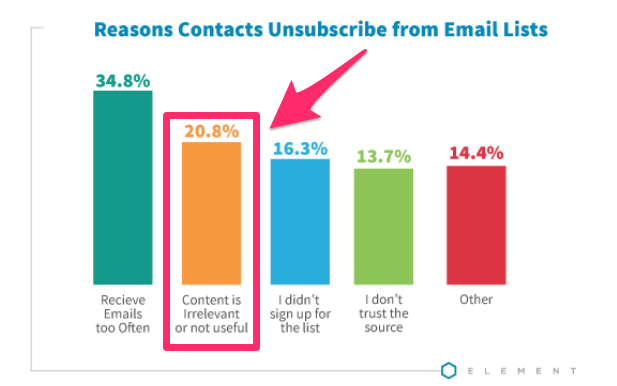
Irrelevant content is the second most common reason why people unsubscribe from email lists.
You worked hard to get them to sign up, but all of that will be thrown away as soon as they unsubscribe. You need to avoid that.
Email segmentation is a must if you want to deliver relevant marketing content to your subscribers.
If you’ve never segmented your email lists or your current segmentation methods need improvement, you’ve come to the right place. I’ll explain what you need to do to elevate your email marketing strategy with segmentation tactics.
Encourage your customers to create profiles
Often, businesses don’t segment their email lists because they simply don’t have enough information to do so.
How can you segment your subscribers if the only piece of information you have about them is their email address? Email addresses alone won’t be enough.
That’s why you should encourage your customers to create profiles on your website.
You’ll use these profiles to improve their shopping experience. Then they can store their payment information, billing addresses, manage their order histories, etc.
But these customer profiles will benefit your segmentation strategy as well.
You’ll get more information about each customer. And you can use that information to segment your lists accordingly.
That said, customer profiles shouldn’t be a requirement.
Some ecommerce shops force customers to create profiles just to buy something. I strongly advise against this strategy.
In a perfect world, yes, they’ll create profiles. But you don’t want to lose conversions because of this.
Instead, try to give them a reason to sign up. Here’s an example from the Lululemon website:
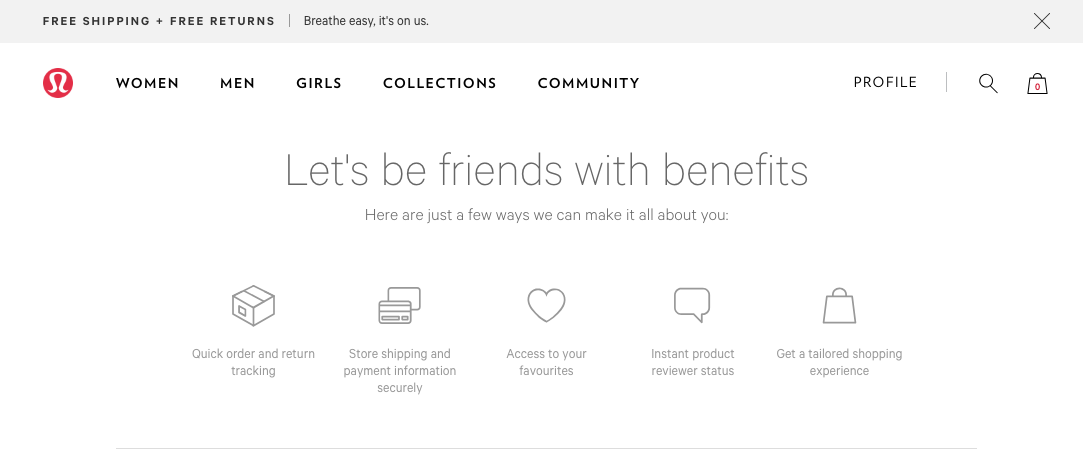
As you can see, they list the benefits of creating a customer profile.
No hard sell or any pressure to do so. People who create a profile will benefit from:
- tracking orders and returns
- stored payment information
- favorite products
- customized shopping experience
When the customer creates a profile, you’ll collect more information about them. We’ll talk more about what type of info you should be asking for as we continue through this guide.
Don’t ask for too much information right away
If people want to sign up to receive emails from your company, they shouldn’t have to submit a blood sample to do so.
Obviously, I’m exaggerating here. But you’d be surprised at the number of form fields some brands require when a customer signs up for email content.
I understand your reasoning behind this.
The more information you get from your customers, the easier it will be to segment them into different categories. However, if you ask for too much, it will turn people away from signing up in the first place.
Why should they trust you with personal information that’s, in their opinion, irrelevant to their shopping experience? They just won’t sign up.
Plus, you can still come up with effective segmented lists with just a few form fields.
Here’s a great example from the Champs Sports website:
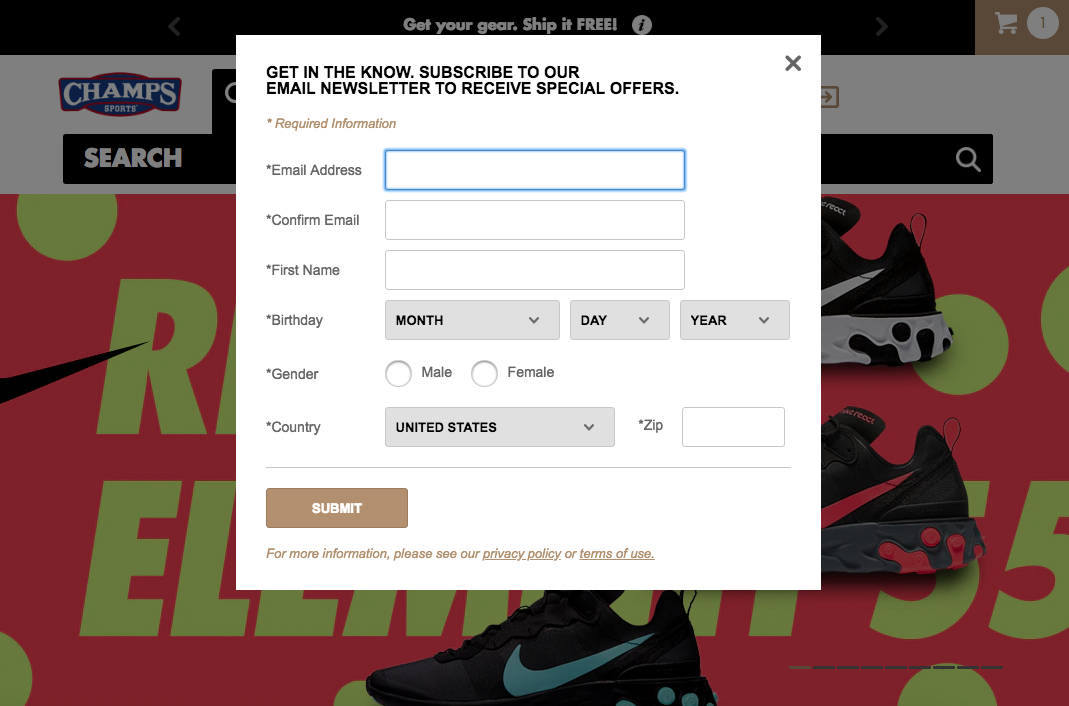
In addition to asking for a website visitor’s email address, Champs also requires them to give their first name. While this won’t necessarily help them segment their subscribers, it will help them personalize their messages.
With the information on this list, Champs can segment new subscribers based on:
- age
- gender
- location
That’s plenty. You can create multiple lists with just those three pieces of information.
For example, one group could be females between the ages of 18 and 25 living in New England.
The content they receive would be significantly different from a group of men between the ages of 35 and 50 living in southern California.
Limit the form fields on your opt-in page. There’s no reason for you to know their favorite color or mother’s maiden name.
The more information required to sign up, the fewer people will subscribe.
Let your subscribers customize their content
Another way to deliver relevant marketing content is by simply asking your subscribers what they want to receive.
If they can customize the type of emails you send, they won’t be surprised or annoyed when they get a message. Everything delivered to their inbox will be extremely relevant.
Set up these options through your customer profile settings, which we just talked about.
In addition to letting people customize their email content through their profiles, you can give them options on the types of content they want to receive when they initially sign up.
Here’s a great example of this strategy used by Lowe’s.

Lowe’s only asks for the customers’ email addresses and zip codes. They can use this to segment their audiences by location.
But look at how Lowe’s offers customizable email options.
By default, everything is checked. However, people can uncheck the types of content they find irrelevant.
For example, let’s say someone wants to receive only marketing promotions from this company.
Any time they got a message about home improvement tips or upcoming events, they would be annoyed. These newsletters are irrelevant to them.
They can opt out of those by simply unchecking the appropriate boxes when signing up in the first place.
Use the double opt-in strategy
When I work with other businesses, I see this problem all the time.
They have many subscribers on their email lists that don’t belong there. That’s because some people provided their email addresses without realizing what they were getting into.
To get more subscribers, some websites have a default setting during the checkout process to join their email lists.
But the customer doesn’t realize they’re going to get bombarded with marketing emails just because they wanted to buy something.
While I don’t have a problem with this strategy overall, it needs to be implemented with a double opt-in to complete the signup process.
Your content won’t be relevant if it’s being delivered to people who subscribed by accident. Double opt-ins help ensure that subscribers actually want to receive marketing messages from your business.
The easiest way to implement a double opt-in verification message is with a welcome email:
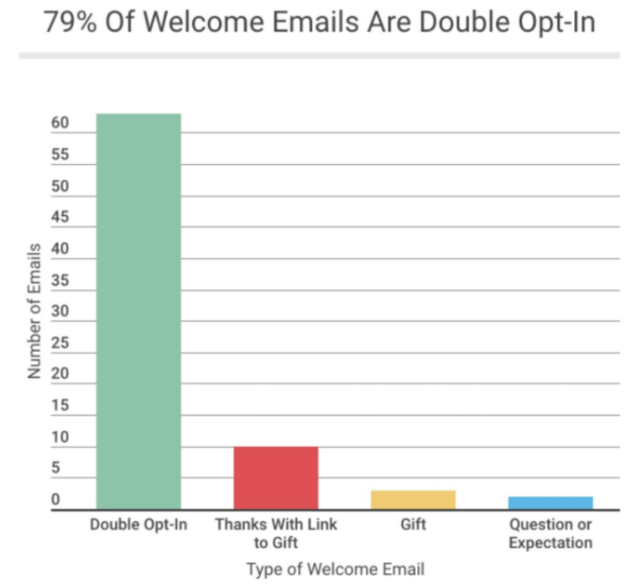
Once a new subscriber confirms they want to be on your email list, you can segment them based on the factors I previously discussed and will continue to cover moving forward.
If a customer doesn’t complete the process, don’t send them emails unless it’s related to their order.
Segment based on engagement
Another way to segment your subscribers is based on how they responded to previous emails you sent.
You should be tracking actions such as:
- opens
- clicks
- conversions
Then, segment your subscribers accordingly based on this behavior.
For example, someone who never opened an email could potentially get a similar promotion in the future. Whereas a subscriber who already opened that message shouldn’t receive it again. It’s irrelevant to that person.
This tactic will help you improve your open rates and other metrics due to your segmentation strategy.
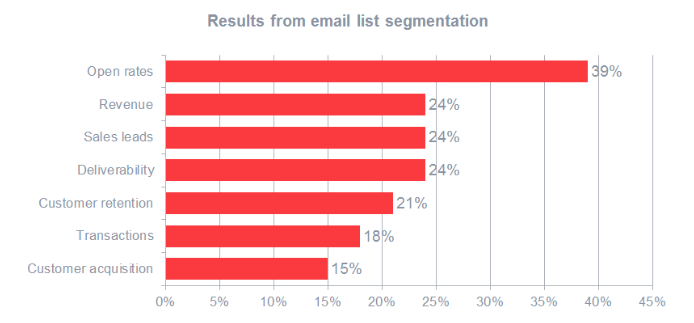
Segmenting based on engagement is another way to take advantage of your customer profiles, which I discussed earlier.
When someone browses on your website while logged in to their customer profile, you can segment them based on their browsing behavior, purchase history, and the frequency with which they visit your site.
Someone who is on your site weekly shouldn’t get an email saying “we miss you.”
That type of message is only relevant to subscribers who have been inactive for several months.
Understand the needs of your B2B clients
Segmenting email subscribers is extremely important for B2B companies. It’s a great way to improve your overall B2B marketing strategy.
Those of you who operate a B2C and B2B company should have those two categories segmented, at the very least. But you should take that one step further on the B2B end.
Your B2B lists should be even more specific than your B2C lists.
The number one factor contributing to B2B marketing success in the previous year was creating higher quality and more efficient content:

Understand who will be receiving these emails.
You can segment these lists based on a job title. Company owners who have more buying power and final decision-making should not get the same messages that a warehouse manager would.
Segment your B2B lists based on industry, company size, and marketing budget.
Your clients that spend $50,000 a year on your products and services shouldn’t be getting the same marketing content as B2B clients that spend $5,000 annually.
Put your subscribers into customer groups
My last point leads to the next one: not all your customers are the same.
Put them into groups based on a number of factors related to their status as a customer as opposed to general factors such as their age and location.
For example, new customers shouldn’t be getting the same emails as people who subscribed over a year ago.
A great way to start communicating with your new subscribers is by creating a series of actionable drip campaigns.
If you put all your customers into one group, you won’t make as much money from them. Here’s what I mean.
Your customers who spend the least amount of money shouldn’t be getting emailed about your most expensive products. Instead, send them promotions that entice them to spend a little bit more or shop more frequently.
That’s why segmenting your subscribers based on spending is an effective strategy.

Targeted emails based on this type of segmentation yield an average of an additional $14 in sales per subscriber.
Some of you may have nearly 10,000 or more subscribers on your email lists.
So do the math. These additional profits will add up quickly.
Send birthday emails
As we’ve seen throughout this guide, age is a great way to segment your subscribers for a number of reasons.
But you can do even more with that information if you have it.
It may sound cheesy, but sending birthday promotions to your subscribers can go a long way. You can take advantage of their birthdays more than just once a year.
Take a look at how The Hook Up uses this strategy to send an email on its subscribers’ half birthdays:
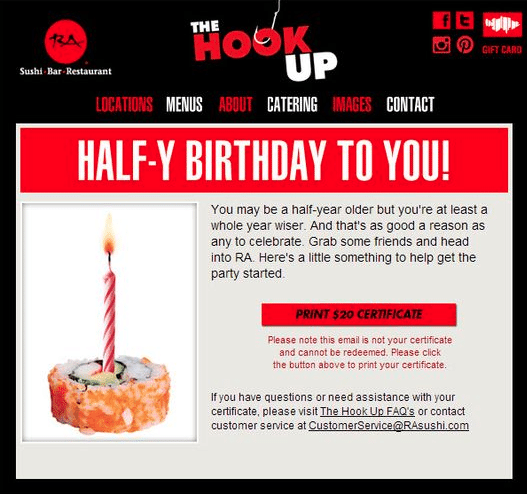
This personalized content is extremely relevant to the recipient.
It’s unique to each subscriber. Discounted dinner for being a half year older? Sign me up.
You can even start birthday promotional messages early.
For example, let’s say your email lists are segmented by birthday months. Everyone who has a birthday in November can receive a message in October about getting ready for their birthday with a new pair of shoes or something along those lines.
Obviously, you’ll tailor the message accordingly based on your business, but you understand what I mean.
Start small
Right now, some of you might not be segmenting your subscribers at all. Don’t get overwhelmed and bite off more than you can chew when you start.
Research shows that half of businesses aren’t segmenting email lists. So you shouldn’t be too alarmed yet.
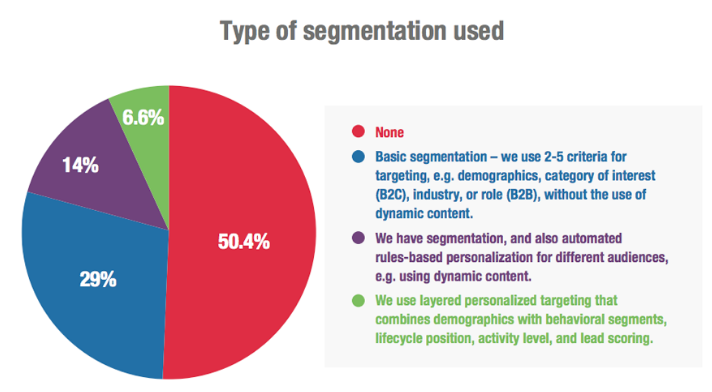
Don’t try to come up with dozens of different lists right away.
Start by trying to segment your existing subscribers. Send a poll to the people on your email list about their interests, and group them accordingly.
Change your current landing page to get more information from new subscribers.
You need to walk before you can run. Starting slow will help you make sure you get things right.
The last thing you want to do is put people on the wrong list. That strategy will backfire because your content will be more irrelevant to them than ever before.
Conclusion
Segmenting your subscribers is the key to email marketing success.
If you learn how to segment your customers accordingly, your marketing content will be more relevant. As a result, fewer people will unsubscribe from your list, and your email campaigns will be more profitable.
Encourage your customers to create a profile. Just don’t force them to give you too much personal information.
On sign-up, let your customers customize the type of content they want to receive.
Use a double opt-in landing strategy to make sure people actually want to be on your email marketing list.
Segment subscribers based on engagement, browsing history, and previous purchases.
Understand the difference between your B2C and B2B clients. Your B2B lists should be even more specific.
Group your customers based on spending habits.
If you’re new to email segmentation strategies, start small. Focus on the basics before you try more complex tactics.
Ultimately, this will help you deliver relevant marketing content to all your subscribers.
How is your brand segmenting subscribers on your email lists?
from Quick Sprout https://ift.tt/2CIrR2T
via IFTTT
